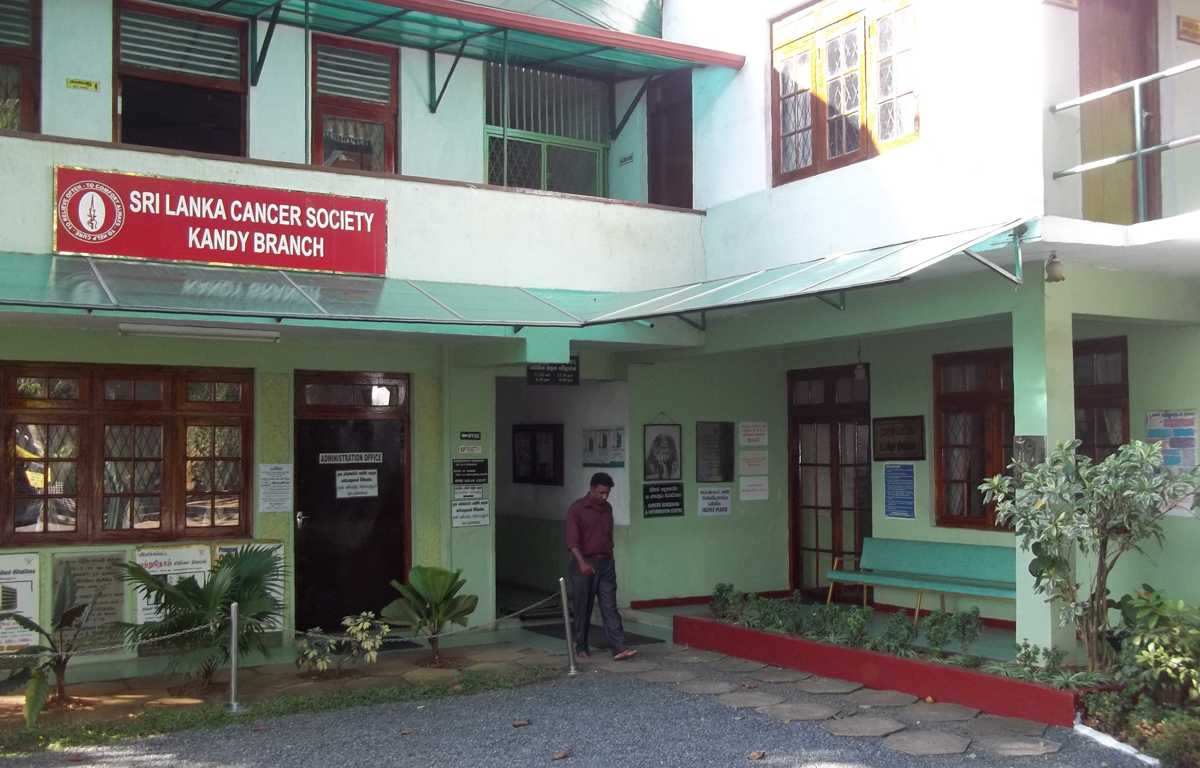
From Bangkok with Metta, November 17, 2015
A topic that seems to rear it fearsome head everyday in the news is climate change, sometimes referred to as "global warming," but more appropriately, perhaps, as "climate crisis." This concern is so relevant to our current situation, that, when we were asked by the editors of Lankataman, the annual journal of the Burmese monks in Sri Lanka, to write an article for the next issue, we chose it as the most suitable subject. We had first tried to write a history of the Kandy Intensive Buddhist English Course, but soon realized that a rehash of our previous reports was intensely boring. (Is that an oxymoron?) Our articles for past issues have included "Sketches of a Burmese Sayadaw in Japan: An Appreciation of Ven. U Khe Min Da" and "Sangha sans Frontières"
We have frequently used environmental issues in our teaching. In 2007, students in Kolkata watched Al Gore's documentary, "An Inconvenient Truth," several times. Since none of the monks studying with us had had any exposure to basic science or math curricula in their education in Burma, the graphs and tables or percentages and comparisons with past Co2 levels had little meaning for them. Dr. Nandobatha and Rajiv did a great job translating the narration and clarifying the concepts. Everyone gained a deeper understanding of global warming, and the discussions were meaningful.
A couple of years ago, we developed an extended exercise which included a wide range of environmental problems, including climate change, ocean acidification, habitat destruction, over-fishing, air pollution, fracking, and the rapid extinction of vultures on the subcontinent. Each student chose one of the topics, did a bit of research, and made a presentation in class.
Pope Francis |
The Dalai Lama |
|
|
|
|
|
|
Ven. Bhikkhu Bodhi |
|
|
|
|
We were satisfied with our effort, but wondered whether the vocabulary and concepts in the article might be too challenging for the magazine's readers. (Most of the articles in the magazine are in Burmese.) The day after we submitted the article to the editors, we contacted a physicist, our old friend, Dr. Kyaw Tint. He immediately offered to translate the article into Burmese, and the editor readily agreed to include both the original and the translation. We are very pleased. As soon as the issue is printed, we will include the article in a report.
World news certainly does not offer much optimism for our planet. The United Nations has just pointed out that conflicts around the world have created more than 60 million refugees and displaced persons. Fires are raging in Indonesia to make way for palm oil and soy bean crops. WWF has reported that half of the world's species of wildlife have disappeared in the last forty years. Mankind continues to act like an unstoppable virus. All life ends in death, but extinction is another matter. What to do about it? What else but avoid evil, do good, and purify our minds. We completely agree with Ven. Bhikkhu Bodhi that we have a great opportunity to act with conscientious compassion.
 |
|
| Click the photo to see more photos of the high tea at the Cancer Society | |
 |
|
| Click the photo to see more photos of the "estate." | |
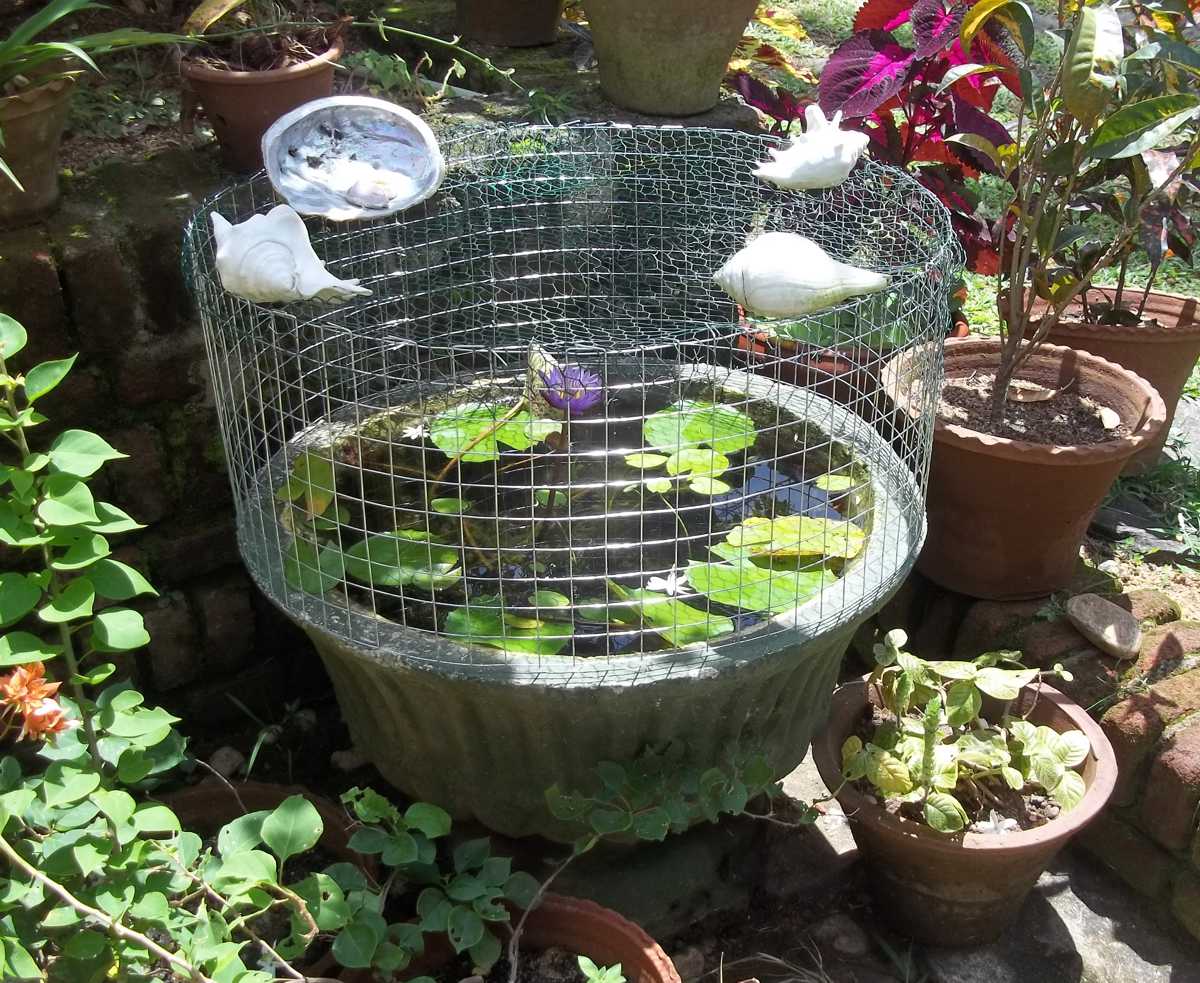 Monkeys aren't the only greedy ones around. We have a resident kingfisher, whose morning trills are a thrilling wake-up. With his stunning bright plumage and brilliant song, what's not to love? His appetite for our little fish! We have a variety of small fish to feed on the mosquito larvae which are bound to hatch in our various pots of lotus, water lilies and water hyacinth. Dengue fever is rampant in many parts of Sri Lanka, and we don't ever want to come down with it again. Twice in Thailand was quite enough! How to protect our small fish? Again, we turned to Nimal, and he crafted attractive wire covers which allow the water flowers to bloom but thwart the kingfisher.
Monkeys aren't the only greedy ones around. We have a resident kingfisher, whose morning trills are a thrilling wake-up. With his stunning bright plumage and brilliant song, what's not to love? His appetite for our little fish! We have a variety of small fish to feed on the mosquito larvae which are bound to hatch in our various pots of lotus, water lilies and water hyacinth. Dengue fever is rampant in many parts of Sri Lanka, and we don't ever want to come down with it again. Twice in Thailand was quite enough! How to protect our small fish? Again, we turned to Nimal, and he crafted attractive wire covers which allow the water flowers to bloom but thwart the kingfisher.
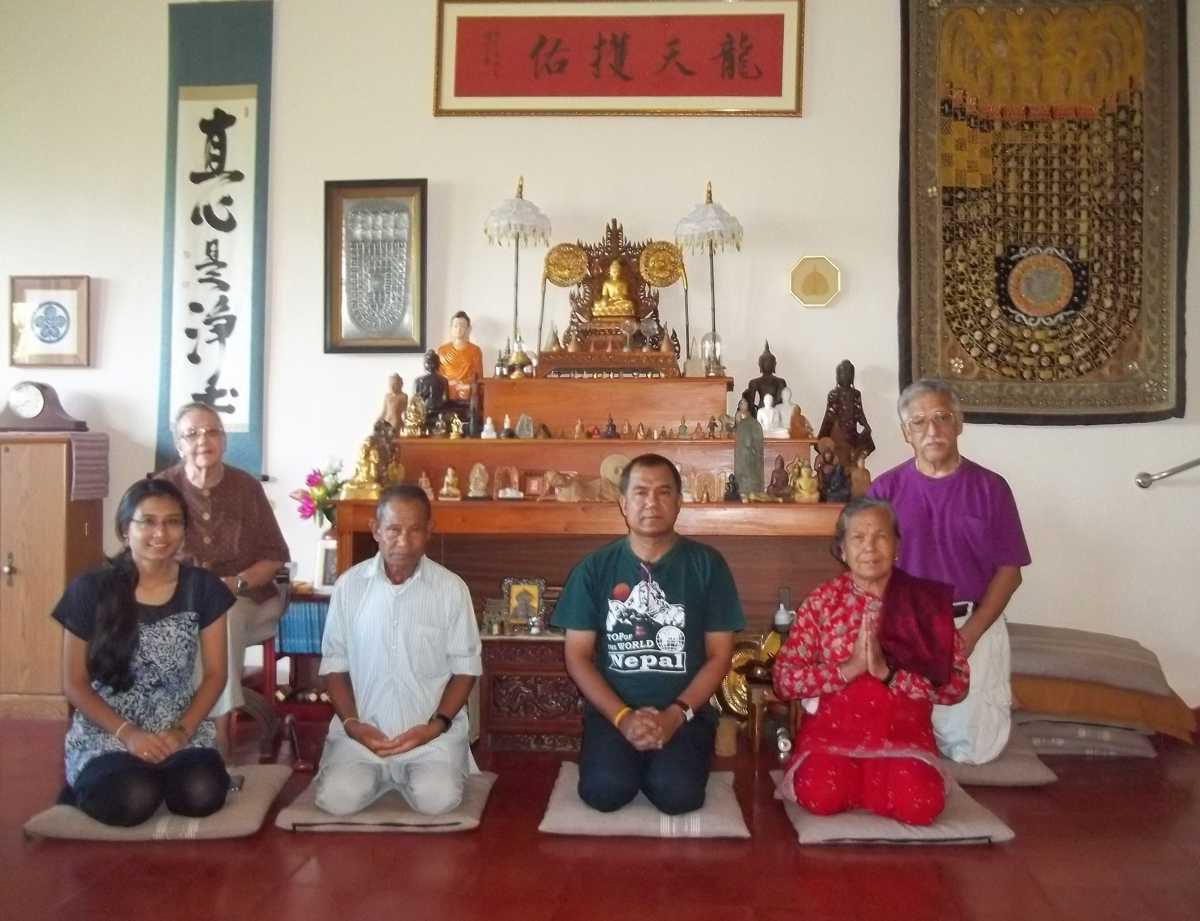 |
|
| Click the photo to see more photos of Assajita's visit. | |
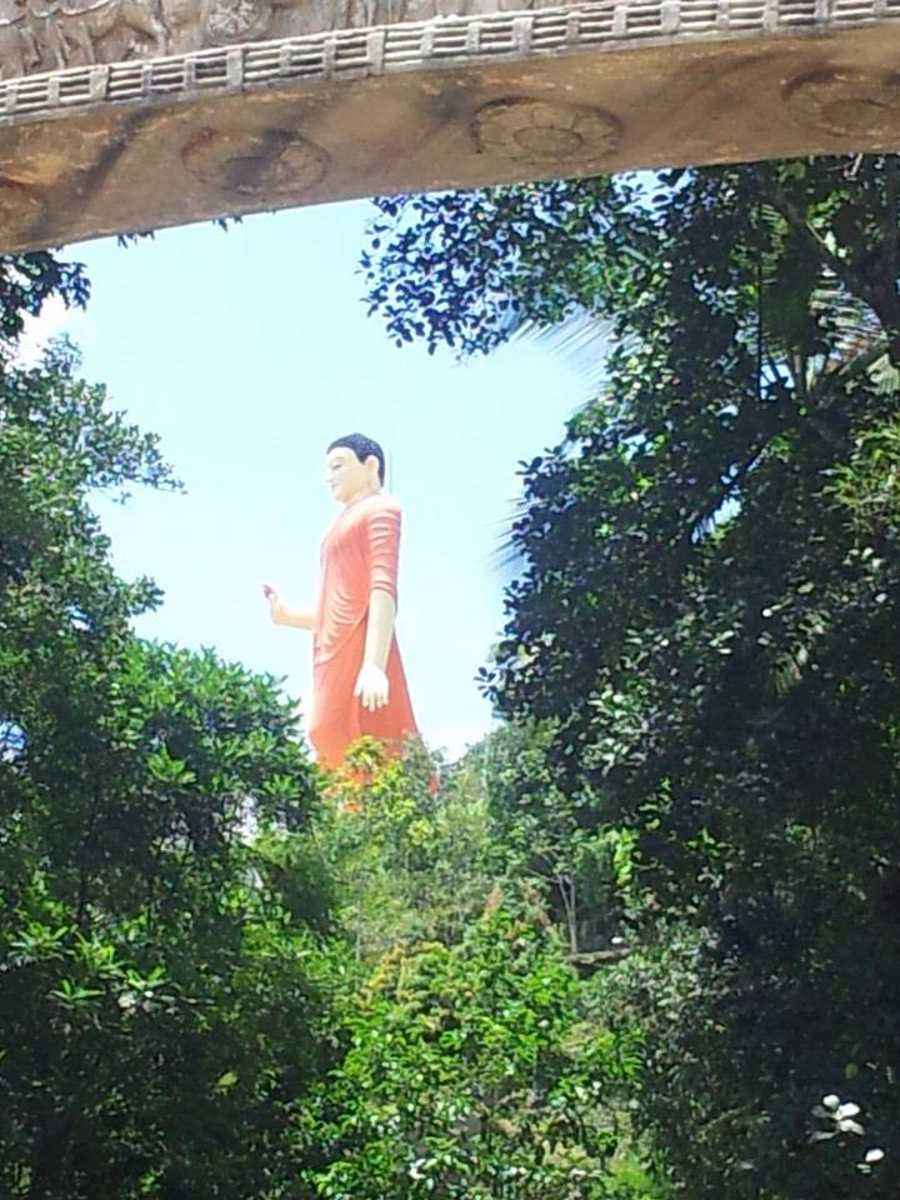 |
|
| Click the photo to see more photos of the temple tour. | |
 For the rest of their time, we couldn't have done better than put them in the capable hands of Jagath, who has a very comfortable new van. They saw everything they wanted to see-- elephants, the Bodhi Tree, the ancient sites, and much, much more.
For the rest of their time, we couldn't have done better than put them in the capable hands of Jagath, who has a very comfortable new van. They saw everything they wanted to see-- elephants, the Bodhi Tree, the ancient sites, and much, much more.
Shortly after they left, Dushy and her friend Carson from Michigan came for a couple of nights. That was another wonderful visit. Dushy sorely needed the time off from her university duties, and Carson is a delightfully droll companion. Asoka took them around Kandy, Jagath drove them to Nuwara Eliya and back, but we enjoyed several interludes of stimulating conversation.
 Some will remember our Dhamma friend Calvin (author of Razor Wire Dharma). In spite of several transfers, he has managed to keep in touch with us. It is often difficult (and expensive) for inmates in the US to do this. Many months ago, he sent us the plans his Buddhist group had for a meditation pagoda on the grounds of the facility where he is detained (although it has been many months since he completed his sentence. The group had raised enough money to complete the pagoda, and the inmates were willing and able to carry out the construction, but the authorities demanded that they engage an engineer to oversee the project. At last, they were able to do this, and the pagoda was finished. It is believed to be the first Buddhist construction in any detention facility in the United States! We received an invitation to the dedication ceremony on September 16, but Washington State is a bit far from Sri Lanka. We wondered what we could send as a "pagoda-blessing" gift. One day, at the supermarket, we met our kind and generous neighbor Veena, who presented us with a a delicate white porcelain Buddha image produced at her daughter's factory in Colombo. She apologized that she had only one with her, but she promised to bring us several more to give to friends. We immediately realized that this was the perfect gift, and it would include her and her daughter in the donation. We carefully wrapped the fragile image in bubble pack and put it in a small box. That box we placed a larger box along with two lengths of colorful Tibetan silk drapery (shambu) that we had bought (We couldn't resist) at Himalaya Residence, along with several copies of Buddhist Crossword Puzzles. As with all prison donations, we needed to speak with the chaplain to learn about all the regulations and restrictions. Happily, he gave us the green light. We calculated and figured we had just enough time for it to reach Washington by airmail (about ten days) in time for the ceremony. Then it dawned on us that Mike was leaving for the States in just a few days, without much luggage. He could send it UPS more cheaply, and it would still be on time. He readily agreed. We wrapped the box in brown paper, addressed it, as instructed, c/o the chaplain, and tied it with string. We also gave Mike another pack of Crossword Puzzles to send to Steve, who is in a prison in the Upper Peninsula.
Some will remember our Dhamma friend Calvin (author of Razor Wire Dharma). In spite of several transfers, he has managed to keep in touch with us. It is often difficult (and expensive) for inmates in the US to do this. Many months ago, he sent us the plans his Buddhist group had for a meditation pagoda on the grounds of the facility where he is detained (although it has been many months since he completed his sentence. The group had raised enough money to complete the pagoda, and the inmates were willing and able to carry out the construction, but the authorities demanded that they engage an engineer to oversee the project. At last, they were able to do this, and the pagoda was finished. It is believed to be the first Buddhist construction in any detention facility in the United States! We received an invitation to the dedication ceremony on September 16, but Washington State is a bit far from Sri Lanka. We wondered what we could send as a "pagoda-blessing" gift. One day, at the supermarket, we met our kind and generous neighbor Veena, who presented us with a a delicate white porcelain Buddha image produced at her daughter's factory in Colombo. She apologized that she had only one with her, but she promised to bring us several more to give to friends. We immediately realized that this was the perfect gift, and it would include her and her daughter in the donation. We carefully wrapped the fragile image in bubble pack and put it in a small box. That box we placed a larger box along with two lengths of colorful Tibetan silk drapery (shambu) that we had bought (We couldn't resist) at Himalaya Residence, along with several copies of Buddhist Crossword Puzzles. As with all prison donations, we needed to speak with the chaplain to learn about all the regulations and restrictions. Happily, he gave us the green light. We calculated and figured we had just enough time for it to reach Washington by airmail (about ten days) in time for the ceremony. Then it dawned on us that Mike was leaving for the States in just a few days, without much luggage. He could send it UPS more cheaply, and it would still be on time. He readily agreed. We wrapped the box in brown paper, addressed it, as instructed, c/o the chaplain, and tied it with string. We also gave Mike another pack of Crossword Puzzles to send to Steve, who is in a prison in the Upper Peninsula.
As soon as Mike got to Michigan, he wrote, informing us that his bag with our parcels had been delayed at the airport. He assured us that the airline had promised to deliver the bag the next day and that he would immediately take the two packages to UPS. Not to worry; there was still time. Within a few hours, there was a second message explaining that, when he opened his suitcase, he discovered that the two parcels had been violently opened and the contents scattered. Fortunately, the Buddha image was still safely packed in its small box, undisturbed. Mike had the addresses, but he didn't know how to divide the items. We surmised that the two parcels had been opened because they were addressed to correctional facilities. Who is going to try to smuggle something nefarious from abroad into an American prison through the chaplain?
 |
|
| Click the image to see th program and the certificate. | |
 In a somewhat related vein, we would like to report that Casey Riverpoint has sold one copy of Buddhist Crossword Puzzles on Amazon.com. The buyer is an inmate in Texas. Will you be the second? Reviews are welcome!
In a somewhat related vein, we would like to report that Casey Riverpoint has sold one copy of Buddhist Crossword Puzzles on Amazon.com. The buyer is an inmate in Texas. Will you be the second? Reviews are welcome!
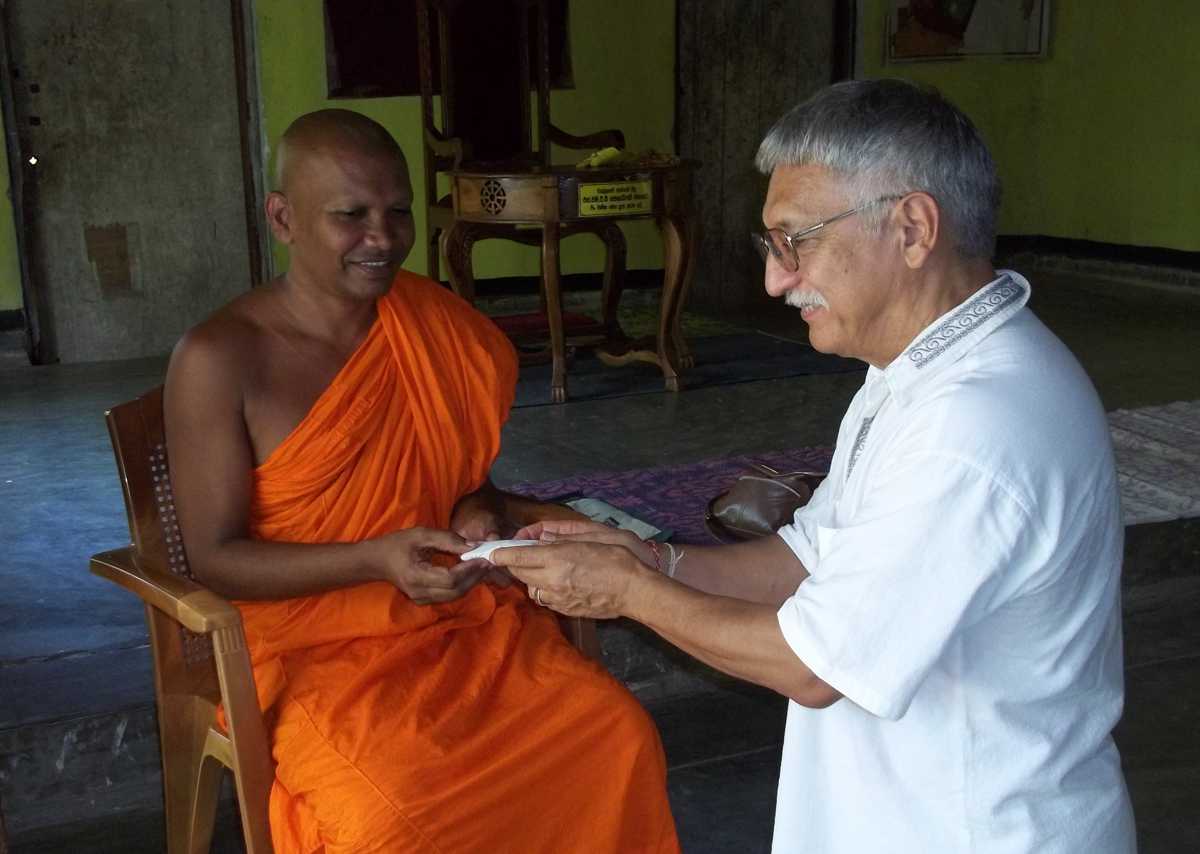 |
|
| Click the photo to see more photos of the visit. | |
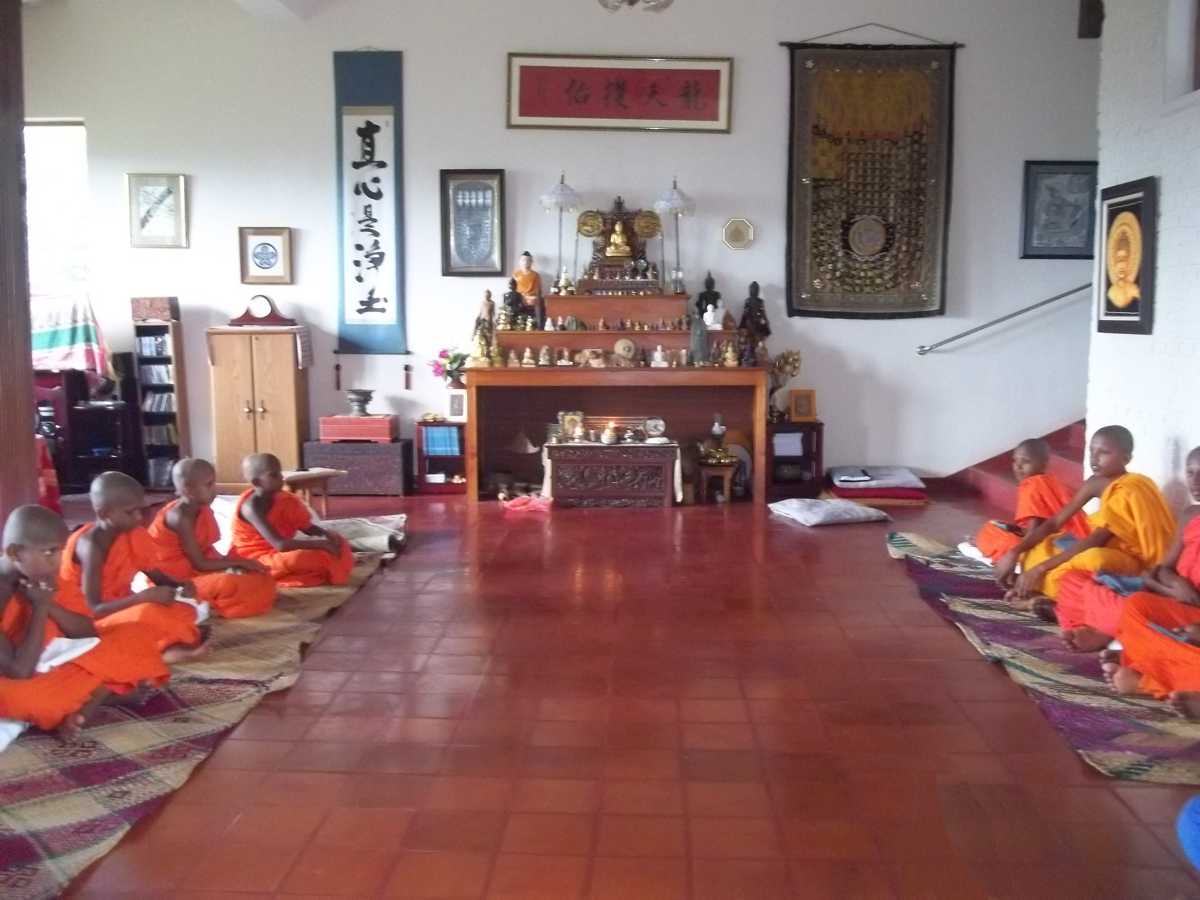 |
|
| Click the photo to see more photos of the dana. | |
 |
|
| Click to enlarge | |
The dana on September 29 was a grand occasion, but, unfortunately, Visakha missed everything. Just the day before, she began feeling ill and went to bed. For the next few days, she suffered alternating chills and fever, but she remembers very little, except getting good nursing from Lily and Ken, drinking lots of liquids, and causing many changes of bedding. There were no dreams--only a strong sense that she was very sick.
The master bedroom is a wonderful room to be ill in. The views outside are marvelous, with various birds visiting the trees, lightning bugs at night, and elegant hand-painted irises from Japan above the windows. Nezumi was good company, and slept almost as much as Visakha did. Finally able to go to see the doctor, Visakha was given a full course of broad-spectrum antibiotics, which seemed to do the trick. Her blood test had some crazy numbers for liver function, but those numbers have come down to normal, and she is finally feeling like a real human being again.
 |
 |
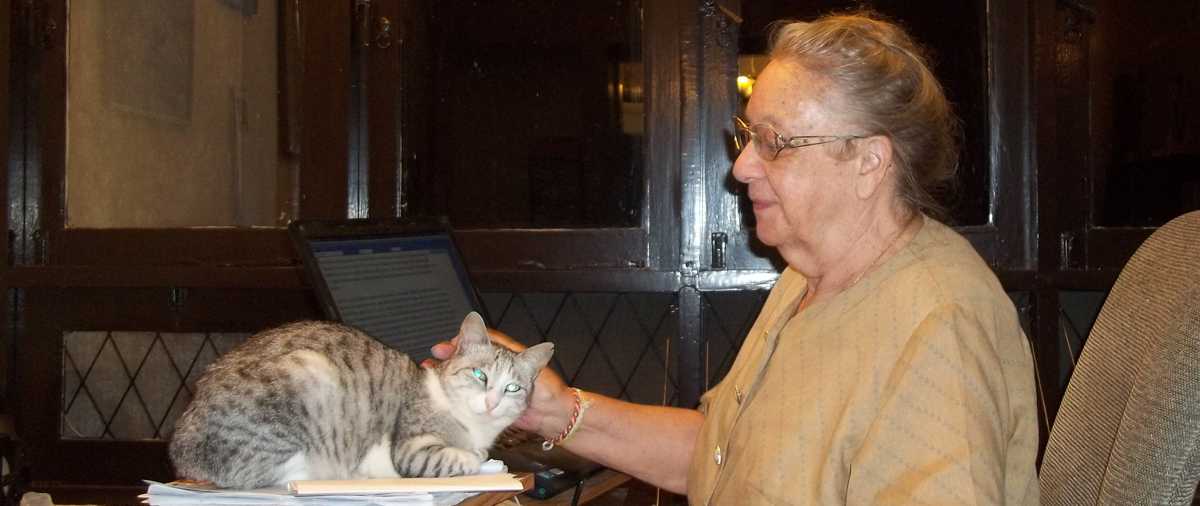 |
|
About the same time, Ken began having serious pains in his right leg, similar to the pains he had had in his left leg several times over the years and which were attributed to a problem with his back. Neither exercises nor physical therapy seemed to offer relief, so he consulted a specialist, who suggested an MRI to diagnose the problem. Inquiry revealed that there would be about a six-month waiting period in Kandy, and the doctor suggested Colombo. A few minutes on the internet, several email messages, and a phone call (essentially free with SKYPE) proved that it would be easy and convenient to have it done in Bangkok. The test is scheduled for the morning after we arrive, with results available two hours later. The charge ends up being less than the cost of the test in Colombo plus the transportation there and back and the overnight stay in a hotel. Would that everything could be so easily arranged!
A couple of months ago, we received an inquiry about Buddhist Crossword Puzzles from Huong, a Vietnamese woman in Australia, who said that she was coming to Sri Lanka to attend an Abhidhamma study group. We thought she wanted only one copy, but she asked us to send thirty to the hotel in Nuwara Eliya where she was staying, and it seems she distributed them to all the participants. After the conference, she came to Kandy and stayed with us for a few days. We felt we'd known her a long time and discovered that we had lots in common as we talked and laughed like old friends. She reminded us of our Vietnamese friends in Japan, where, long ago, we had an association to help refugee resettle in Kansai and to learn Japanese language. Huong is interested in studying Buddhist ESL with Merit and has already completed several lessons with her daughter's help.
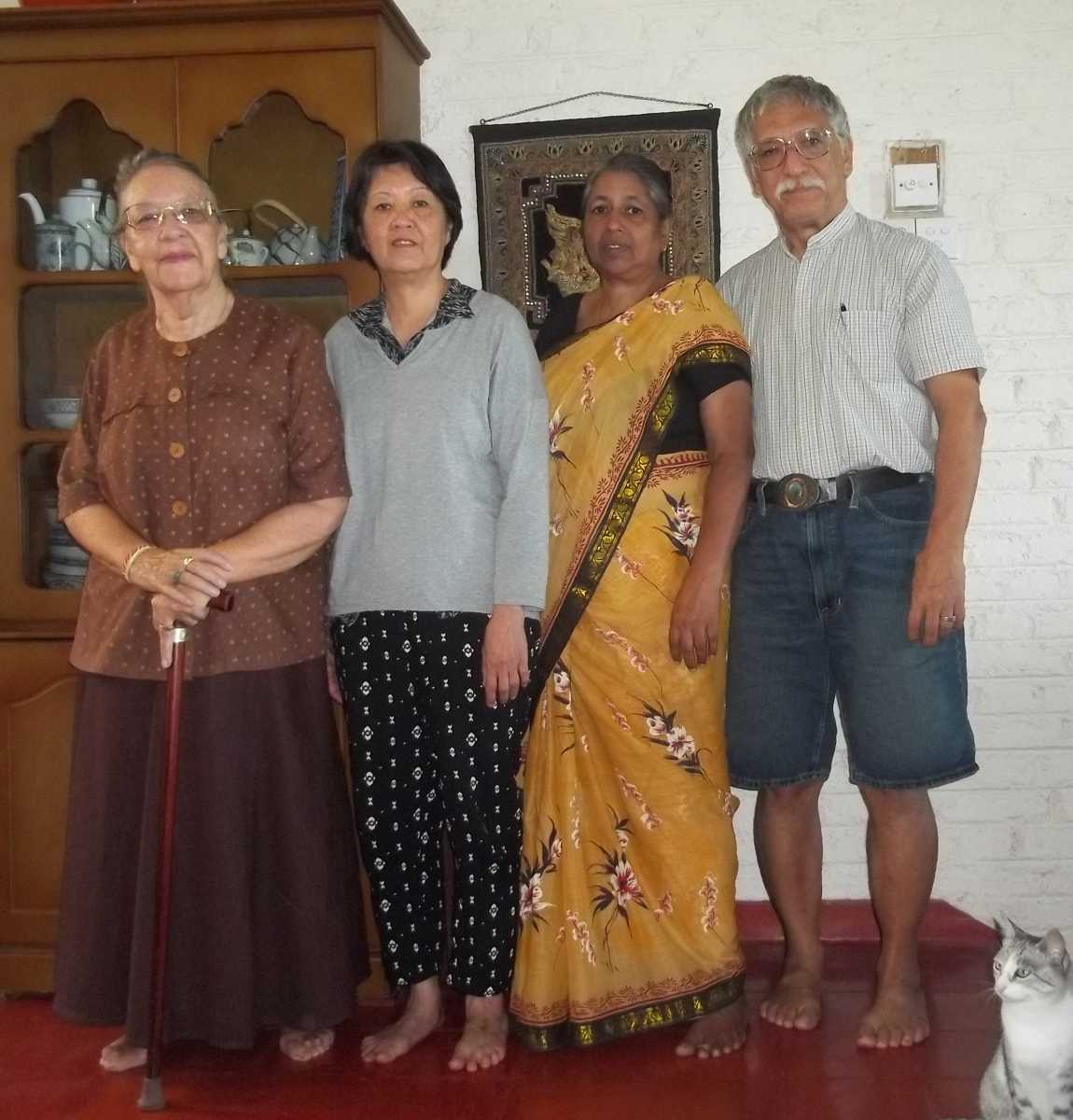 |
 |
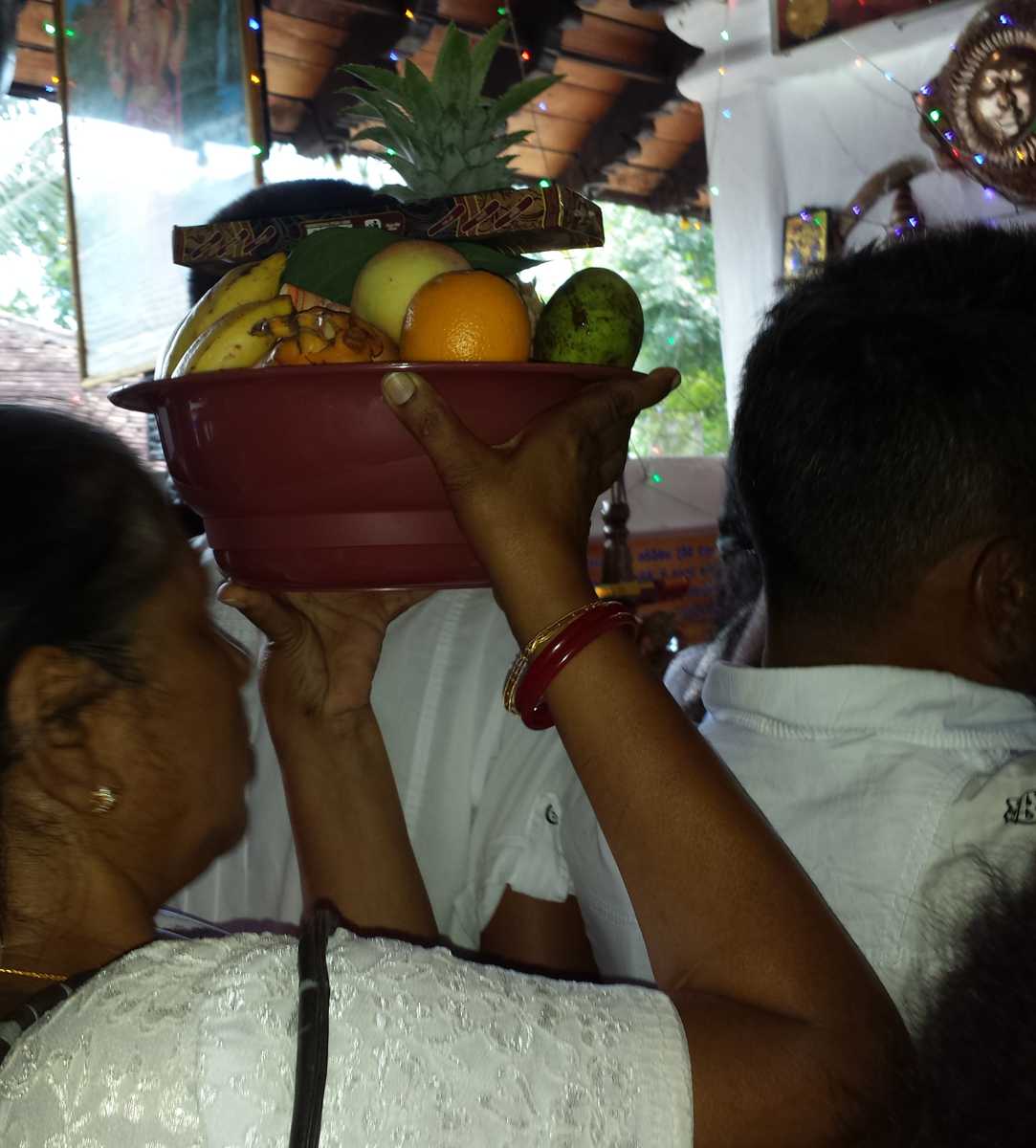 |
|||
|
Huong's photos of Lily at Pattini Devale
|
|||||
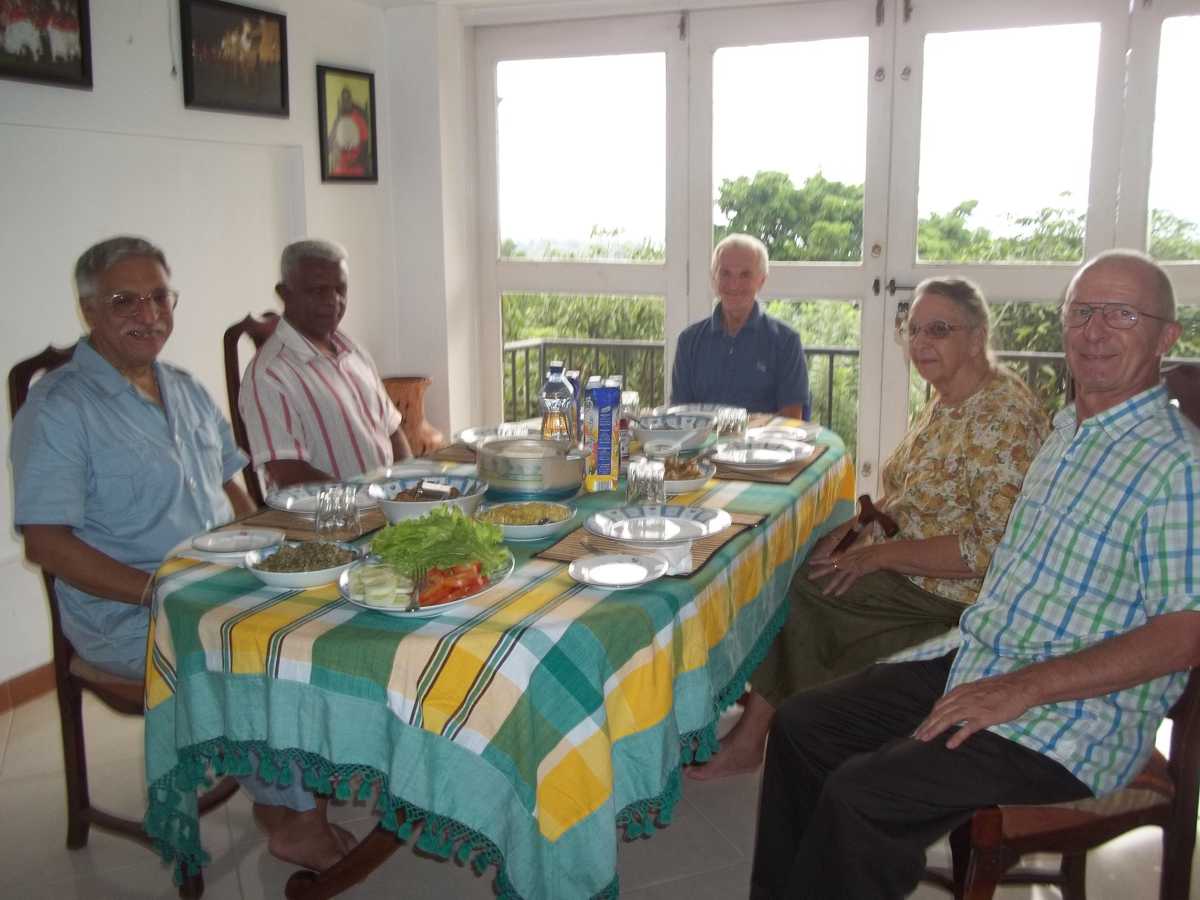 |
|
| Ewen (c) at lunch with Dennis (r) | |
 In October, we quietly celebrated our fortieth wedding anniversary. Nezumi commemorated the day, by giving us a gift, nicely displayed in the courtyard--a neatly killed rat.
In October, we quietly celebrated our fortieth wedding anniversary. Nezumi commemorated the day, by giving us a gift, nicely displayed in the courtyard--a neatly killed rat.
Plans for February's pilgrimage are coming along nicely. How wonderful is that! We're still getting inquiries from potential pilgrims and staying in good contact with Rajiv and Abhijit regarding details. We only hope that the issues between Nepal and India are soon resolved so that we will be able to visit Lumbini.
|
|||||||||||||||||||||||||||||||||||||||||||||||||||||||||||
This year, Amal spent most of the rainy season meditating at Kanduboda Meditation Center near Colombo and was able to sponsor the Kathina. We'd hoped to join in the ceremony, but were still recovering from our various maladies. Nevertheless, Amal allowed us to share in the merit, along with his family and many friends. It was a joyous occasion, and Amal returned to Kandy radiant, happier than we have ever seen him. Sadhu! Sadhu!! Sadhu!!!
 A few weeks ago, Amal introduced us to a Sri Lankan-Australian woman, who has become a Tibetan nun, ordained by the Dalai Lama in Dharamsala. After the earthquake in Nepal, Ven. Lekdron was unable to stay on, so her teacher, Lama Zopa, suggested she return to Sri Lanka to continue her practice. It was wonderful meeting her and having her stay with us for a few days. She is full of energy and eager to establish herself here in Kandy. She understands many of the problems which Sri Lankan women are facing, and she wants to serve as a counselor.
A few weeks ago, Amal introduced us to a Sri Lankan-Australian woman, who has become a Tibetan nun, ordained by the Dalai Lama in Dharamsala. After the earthquake in Nepal, Ven. Lekdron was unable to stay on, so her teacher, Lama Zopa, suggested she return to Sri Lanka to continue her practice. It was wonderful meeting her and having her stay with us for a few days. She is full of energy and eager to establish herself here in Kandy. She understands many of the problems which Sri Lankan women are facing, and she wants to serve as a counselor.
 In one of the lessons in Merit, we mention the international Buddhist flag and the reaction to its being disrespected. This leads to a discussion of potential insults to Buddhism, for example, the use of Buddhist icons in apparel and furniture and the bar in Rangoon, which aroused such controversy last year. In the latter case, the New Zealand manager and two others were charged with "deliberate and malicious acts intended to outrage religious feelings" for posting an ad on Facebook showing a stylized Buddha head with headphones.
In one of the lessons in Merit, we mention the international Buddhist flag and the reaction to its being disrespected. This leads to a discussion of potential insults to Buddhism, for example, the use of Buddhist icons in apparel and furniture and the bar in Rangoon, which aroused such controversy last year. In the latter case, the New Zealand manager and two others were charged with "deliberate and malicious acts intended to outrage religious feelings" for posting an ad on Facebook showing a stylized Buddha head with headphones.
In class, it was interesting that some students made no clear distinction between law and custom, which led to a very muddled discussion and reinforced our determination to include more critical thinking and human rights materials in our curriculum for all courses. In response to the condemnation of those who had been found guilty of committing the offense, we cited Ven. S. Dhammika's remarks about the case:
| The Buddha actually made a comment on this very matter which would be worth keeping in mind. I quote from the Alagaddupama Sutta: "If others abuse, revile, insult or harass the Tathagata…you should not because of that feel annoyance, bitterness or be down-hearted" (M.I,140). I am pretty sure the Buddha would have considered anger on the part of those who know his Dhamma, far more unbecoming than the misuse of his image by those ignorant of it. Let's hope Buddhism is not deteriorating into a religion that reacts with angry indignation and calls for retribution at every slight real or imagined. The three men should be asked to attend several talks on basic Buddhism and the cultural norms of Burma. This way they would respect Buddhism because they understand it, not because they fear it. |
|
Sadly, we are afraid that in some parts of Asia, Buddhism is indeed deteriorating into an intolerant and vengeful religion. It seems that, in addtion to confusing law and custom, some also confuse religion and nationality. This leads to a consideration of the Kalama Sutta, which Ven. Soma Thera calls "the Buddha's Charter of Free Inquiry" because it signifies a teaching that is exempt from fanaticism, bigotry, dogmatism, and intolerance.
|
The reasonableness of the Dhamma, the Buddha's teaching, is chiefly evident in its welcoming careful examination at all stages of the path to enlightenment. Indeed the whole course of training for wisdom culminating in the purity of the consummate one (the arahant) is intimately bound up with examination and analysis of things internal: the eye and visible objects, the ear and sounds, the nose and smells, the tongue and tastes, the body and tactile impressions, the mind and ideas. Thus since all phenomena have to be correctly understood in the field of Dhamma, insight is operative throughout. In this sutta it is active in rejecting the bad and adopting the good way; in the extracts given below in clarifying the basis of knowledge of conditionality and arhatship. Here it may be mentioned that the methods of examination in the Kalama Sutta and in the extracts cited here, have sprung from the knowledge of things as they are and that the tenor of these methods are implied in all straight thinking. Further, as penetration and comprehension, the constituents of wisdom are the result of such thinking, the place of critical examination and analysis in the development of right vision is obvious. Where is the wisdom or vision that can descend, all of a sudden, untouched and uninfluenced by a critical thought? |
|
The sutta itself states:
| "Come, Kalamas. Do not go upon what has been acquired by repeated hearing; nor upon tradition; nor upon rumor; nor upon what is in a scripture; nor upon surmise; nor upon an axiom; nor upon specious reasoning; nor upon a bias towards a notion that has been pondered over; nor upon another's seeming ability; nor upon the consideration, 'The monk is our teacher.' Kalamas, when you yourselves know: 'These things are good; these things are not blamable; these things are praised by the wise; undertaken and observed, these things lead to benefit and happiness,' enter on and abide in them." |
|
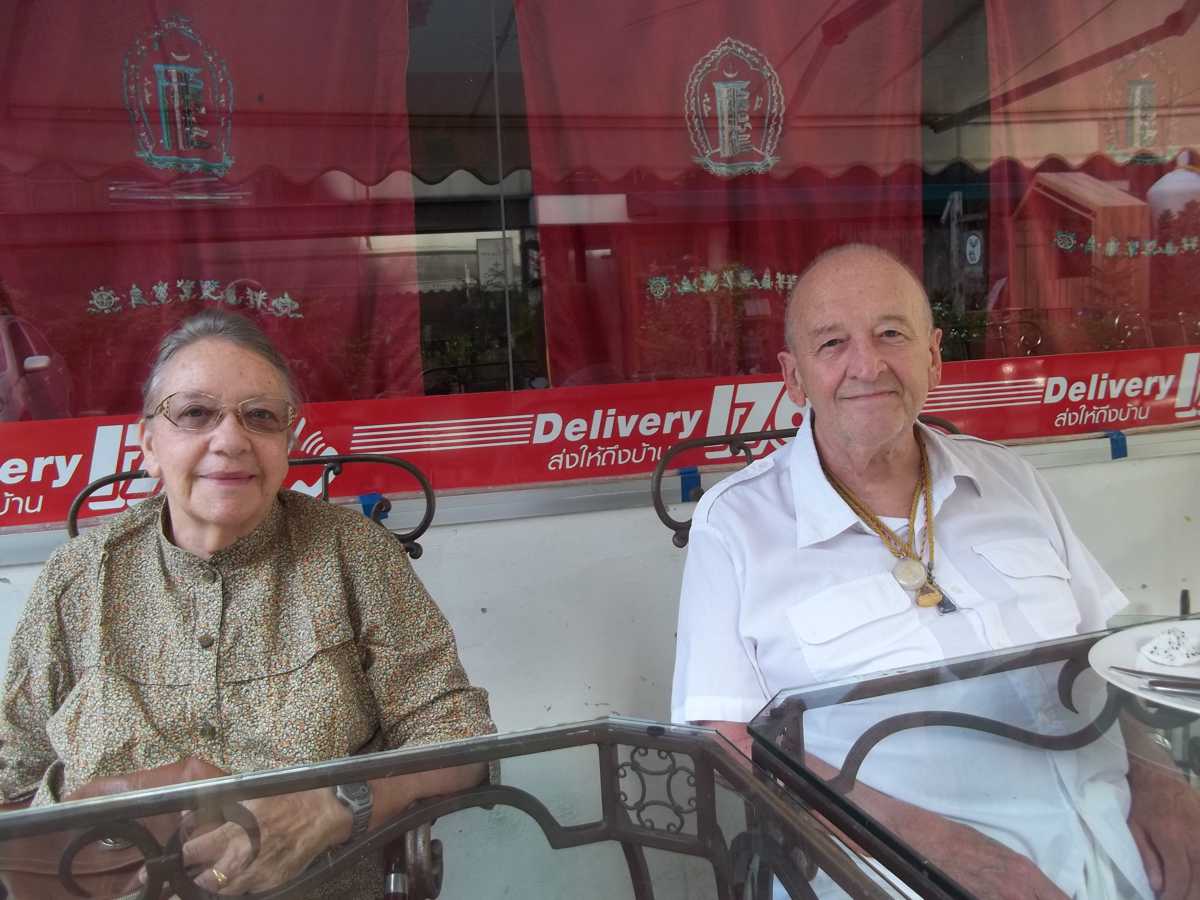 We arrived in Bangkok Monday, November 9. Checked into Himalaya Residence, which is clearly the best guest house in the city! The Nepalese, Tibetan, and Bhutanese dishes are always scrumptious! (We must teach Lily to cook paneer bhujiya!) We met David, who returned about a month ago from Canada, where he had life-saving heart surgery and is recovering nicely. He is as excited as we are about the pilgrimage, and he may visit Sri Lanka, as well. Wonderful! Assajita seems much more relaxed than he did last year. Business seems to be pretty good. He is raffling a round-trip ticket to Nepal, for which we are eligible, but getting back to Bangkok to use it would be a bit difficult. We do hope to visit Kathmandu again someday, however.
We arrived in Bangkok Monday, November 9. Checked into Himalaya Residence, which is clearly the best guest house in the city! The Nepalese, Tibetan, and Bhutanese dishes are always scrumptious! (We must teach Lily to cook paneer bhujiya!) We met David, who returned about a month ago from Canada, where he had life-saving heart surgery and is recovering nicely. He is as excited as we are about the pilgrimage, and he may visit Sri Lanka, as well. Wonderful! Assajita seems much more relaxed than he did last year. Business seems to be pretty good. He is raffling a round-trip ticket to Nepal, for which we are eligible, but getting back to Bangkok to use it would be a bit difficult. We do hope to visit Kathmandu again someday, however.
Ken's MRI was accomplished even more easily than anticipated. Bangkok Christian Hospital is extremely efficient and friendly. The test was scheduled for 8 AM. We arrived a few minutes before to register. By 8:15, Ken was inside the machine and listening to the whirr, rattle, and buzz. As soon as the test was finished, we had breakfast in Au Bon Pain, outside the entrance to the X-ray center. Then we zipped across the street to Modern Optical, where we have bought our glasses for the last twenty years. One of the women who have always taken care of us has retired, but the other, Da, is still there and as cheerful as ever. It seems that the shop is always having some promotion or other, and top-quality lenses and frames are cheaper than we can get them anywhere else.
About ten-thirty, Ken returned to the hospital for the MRI results, but they were not quite ready. He decided to ask the screening desk about something he noticed two days before leaving Sri Lanka. Friday, he had felt a strangeness around his waist. Saturday morning, he rolled over in bed several times to figure out how and why the burning sensation on one side of his back kept changing. He considered consulting a neurologist that evening, but thought that perhaps it was somehow related to the back problem and decided not to. Then, that evening, he reached back and discovered a few bumps. He immediately recognized SHINGLES! He had had that herpes virus attack about thirty years ago, but, at that time, the pain was internal and felt like appendicitis or a ruptured intestine. This sensation was more like a raw blister that threatened to split with every movement, but didn't. Sunday morning, he checked the Merck Manual (1985 edition) and learned two things. First, one attack usually confers immunity, but there is recurrence in 2%. (Just lucky, we guess.) Second, there is no specific treatment available. The condition comes and goes. (Just suffer.)
Nevertheless, Ken felt he ought to get a medical opinion, so he asked at the hospital. He was given a wrist band and directed to dermatology. After a wait of only fifteen minutes, he was ushered into the consultation room. The doctor confirmed the diagnosis and informed him that medicine for treatment was available. The medicine might reduce the severity and duration about 15%. He could have either the original medicine (7000 baht [$212]) or the Thai version (2000 baht [$60]). He decided to forego medicine. He asked about swimming. No problem. Anything to do? The doctor gave him a list of foods to avoid: beans and nuts, mushrooms, sweets, chocolate, and sticky rice.
"Look," he said to the doctor, "I have come to Thailand to eat at a Chinese vegetarian restaurant where most of the food is tofu, soymeat, and mushrooms. For months I have been dreaming about somtam (green papaya salad) and sticky rice. Our hotel room is full of nuts and chocolate. How can I avoid those things?"
"Well," she replied with a smile, "everything in moderation."
That evening, David's friend Ae served us a huge plate of the most delicious mango and sticky rice with coconut milk that we have ever tasted. Ken has decided to let the shingles take their course. It just ain't worth it!

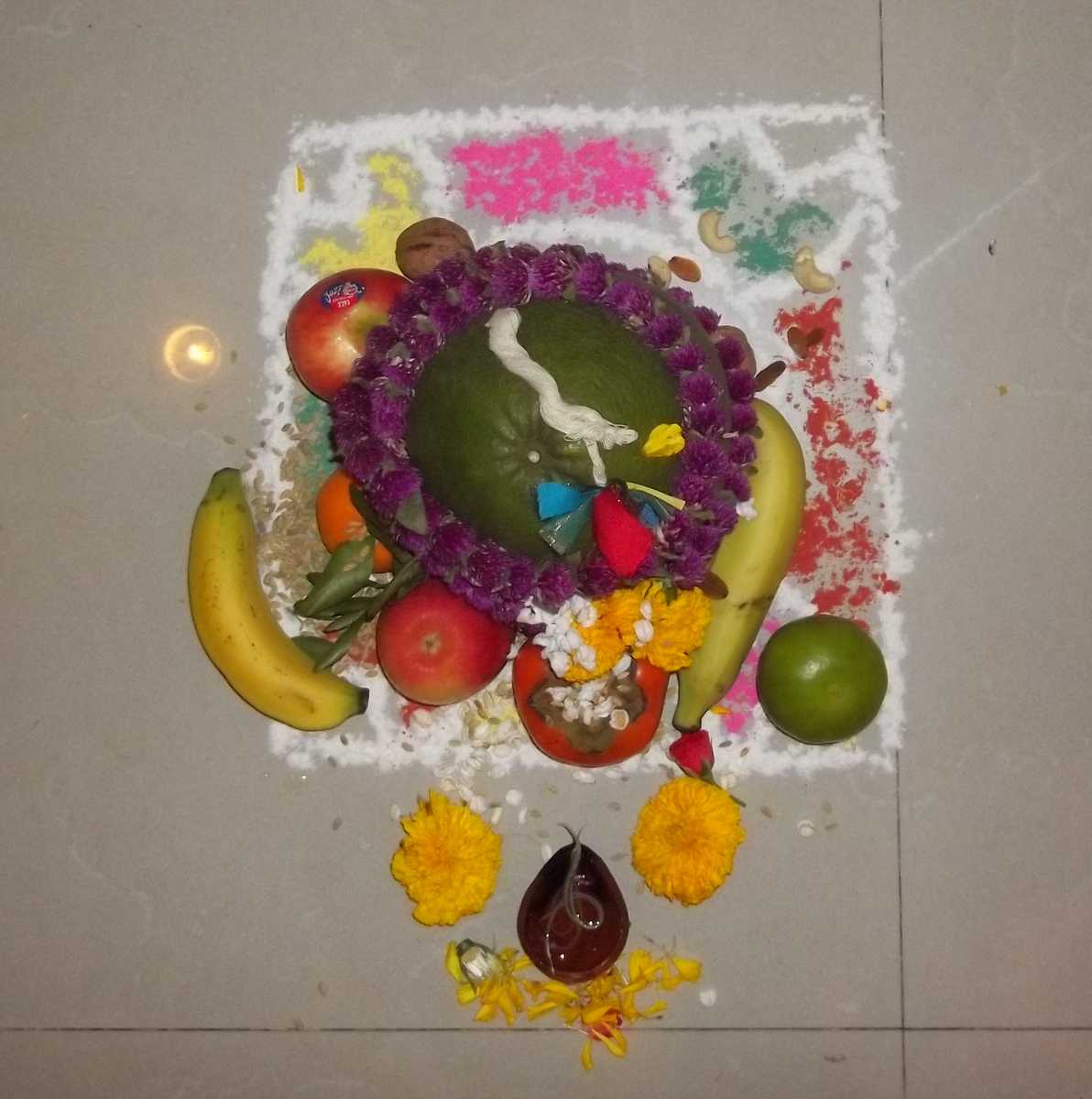 |
|
| Click the photo to see more photos of Divali | |
Assajita explained to us that the Nepalese Deepavali celebration lasts five days. On the first day, thanks is given to the crow, who is the messenger of the gods. Some Nepalese believe that, whenever a crow appears at the window of a house, a letter will soon come bringing news, good or bad, about some relative. On the second day, thanks is given to the dog, who is the guardian of the house and is often more faithful and loyal than some "friends." On the third day, honor is given to Lakshmi, the Goddess of Wealth, with prayers for prosperity during the coming year. Thursday's celebration was the fourth day which marks the beginning of the New Year and is a blessing of the body and a prayer for health throughout the year. On the last day, sisters make offerings to their brothers. This is based on an ancient legend. Once, when a young man was dying, his sister made an offering of walnuts and marigolds to King Yama, the God of Death and Guardian of Hell, asking that her brother remain alive as long as the nuts and the flowers remained fresh. Her wish was granted. Since then, every year, every woman and girl, remembering that promise, honors her brothers. Assajita explained that, if he isn't with his sister, he must call home to take part in this ceremony. It was touching to realize that his family in Nepal was performing the ceremony Thursday night at exactly the same time as we were in Bangkok.
 Here we are, all dolled up for a dinner party. Visakha's beautiful dress was made quite recently by Julie, designed by Moon. It got tons of compliments at the party, due to the design which showed off the Burmese fabric so advantageously. Until we visited them in their new shop, we had no idea of all they'd been through. They'd been in the shop on New Road, just down from the Oriental Hotel for 29 years. We'd first gone there, probably in '84, when all was still quite new, and we'd met their late father there, as well. For many years they'd had no idea that a former relative, a co-signer on the deed, had used the shop as collateral, borrowing millions of baht against it over the years. Six months ago, they were shocked when the bank asked for repayment of the loan. There was nothing to do but to walk away from the shop--both the first-floor showroom and the workshop above. They managed to keep their good name, to find another location, and to protect all their employees, but all thought of graceful retirement was gone. We are so sorry about it all, but, as always, they merely say "Mai pen rai. It doesn't matter because that is the way the world is. At least we know that we haven't cheated or harmed anyone!" Of course, they haven't, but they certainly have been sinned against themselves.
Here we are, all dolled up for a dinner party. Visakha's beautiful dress was made quite recently by Julie, designed by Moon. It got tons of compliments at the party, due to the design which showed off the Burmese fabric so advantageously. Until we visited them in their new shop, we had no idea of all they'd been through. They'd been in the shop on New Road, just down from the Oriental Hotel for 29 years. We'd first gone there, probably in '84, when all was still quite new, and we'd met their late father there, as well. For many years they'd had no idea that a former relative, a co-signer on the deed, had used the shop as collateral, borrowing millions of baht against it over the years. Six months ago, they were shocked when the bank asked for repayment of the loan. There was nothing to do but to walk away from the shop--both the first-floor showroom and the workshop above. They managed to keep their good name, to find another location, and to protect all their employees, but all thought of graceful retirement was gone. We are so sorry about it all, but, as always, they merely say "Mai pen rai. It doesn't matter because that is the way the world is. At least we know that we haven't cheated or harmed anyone!" Of course, they haven't, but they certainly have been sinned against themselves.
Jitti, Julie's and Moon's brother, is an amazingly resourceful fellow! Several years ago, Phra Apichato, a British monk we had met in Thailand and invited to Japan in 1986, moved to Sri Lanka and again asked for our help. We suggested that he contact Ven. Upatissa in Ja-Ela, and he was given a room in the same temple. Suddenly, some months ago, Phra Apichato died while visiting Thailand. The abbot of the Ja-Ela temple appealed to Ven. Upatissa to get a certified copy of the death certificate in order to satisfy Sri Lankan formalities. Jitti visited the temple outside Bangkok, and managed to secure the necessary papers.
A few days before we left Sri Lanka this year, Amal asked us to find out about the elderly Thai monk who had been so helpful to him years ago in Australia. All he knew was the name and the fact that the monk, if still alive, would be very old. We asked Jitti, and, two days later, he sent us some photos of a 101-year-old monk with that name. It is, indeed, the same monk, and Amal hopes to visit Thailand to meet him.
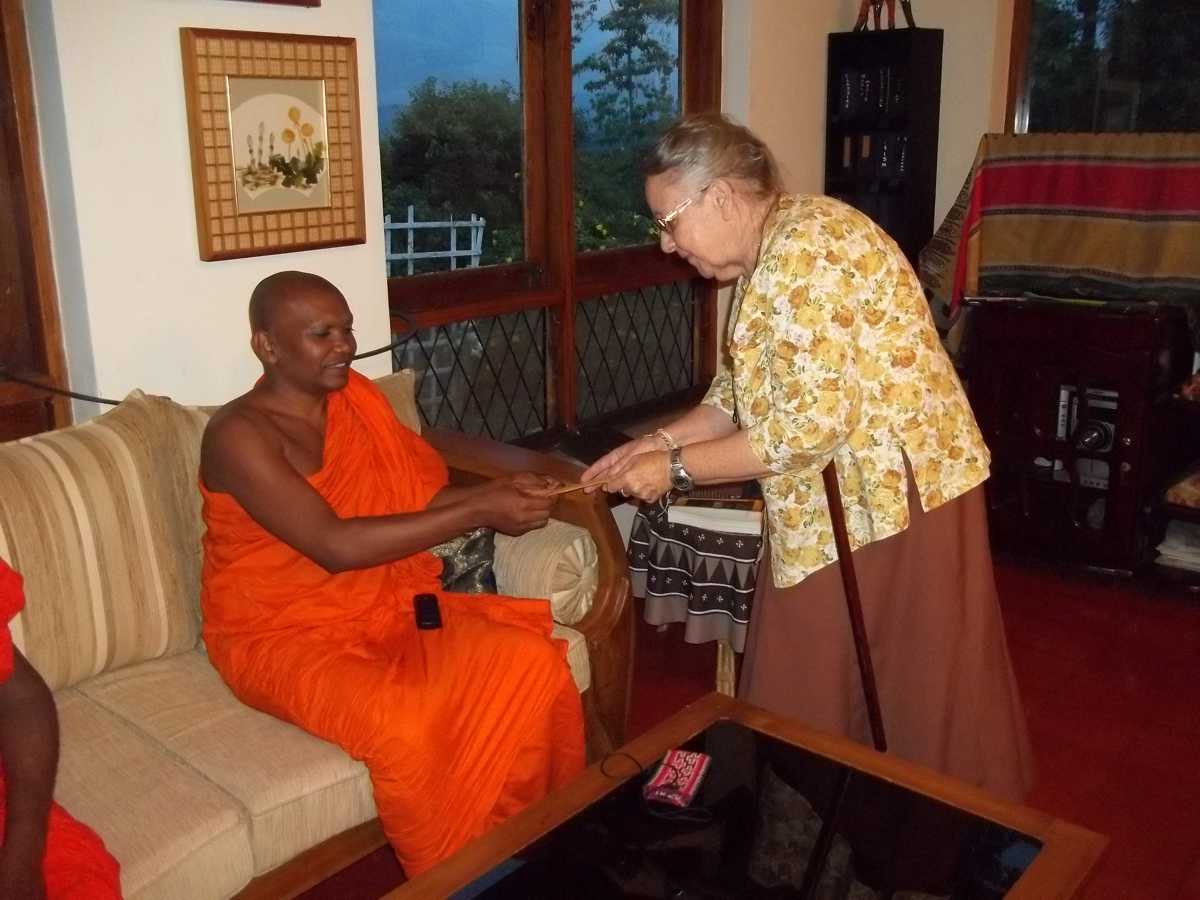 |
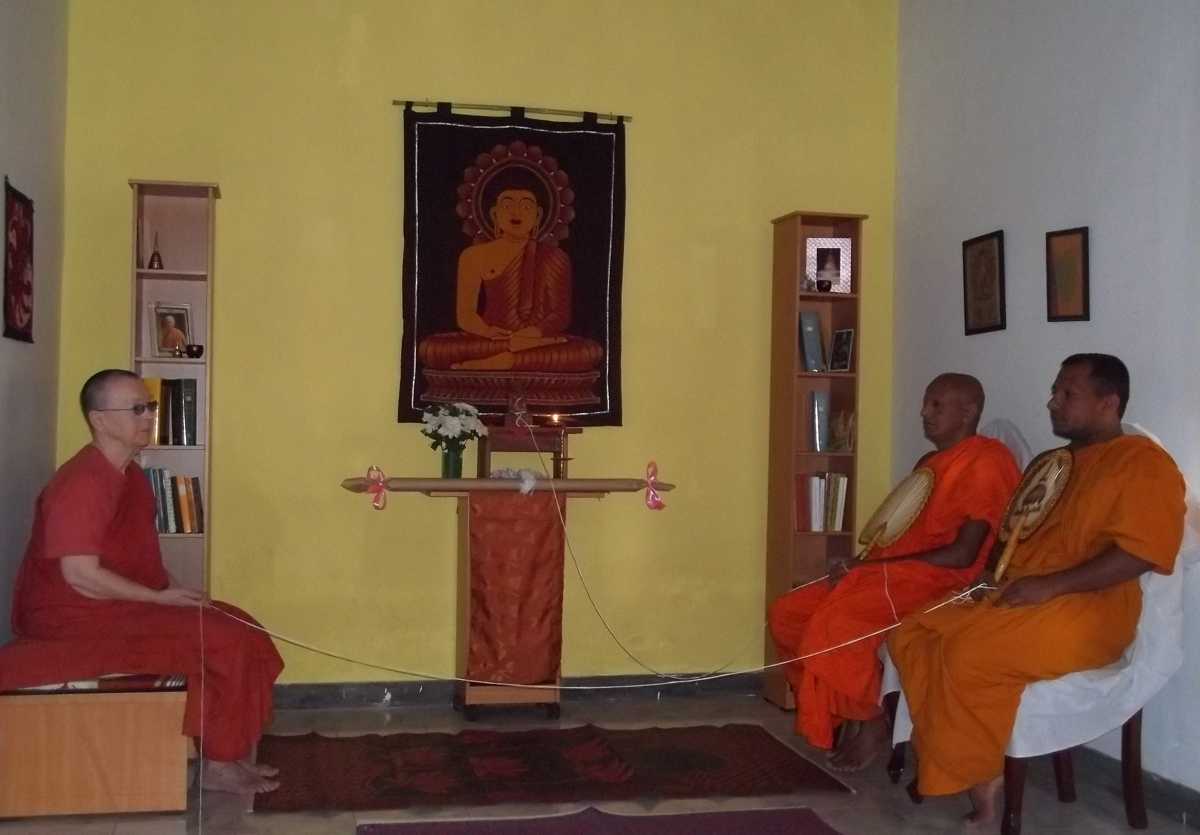 |
 |
|||||||||||
| Ven. Amilsiri in Anniwatte | Ven. Vimala's house blessing | Nezumi eating bamboo. A panda? | |||||||||||
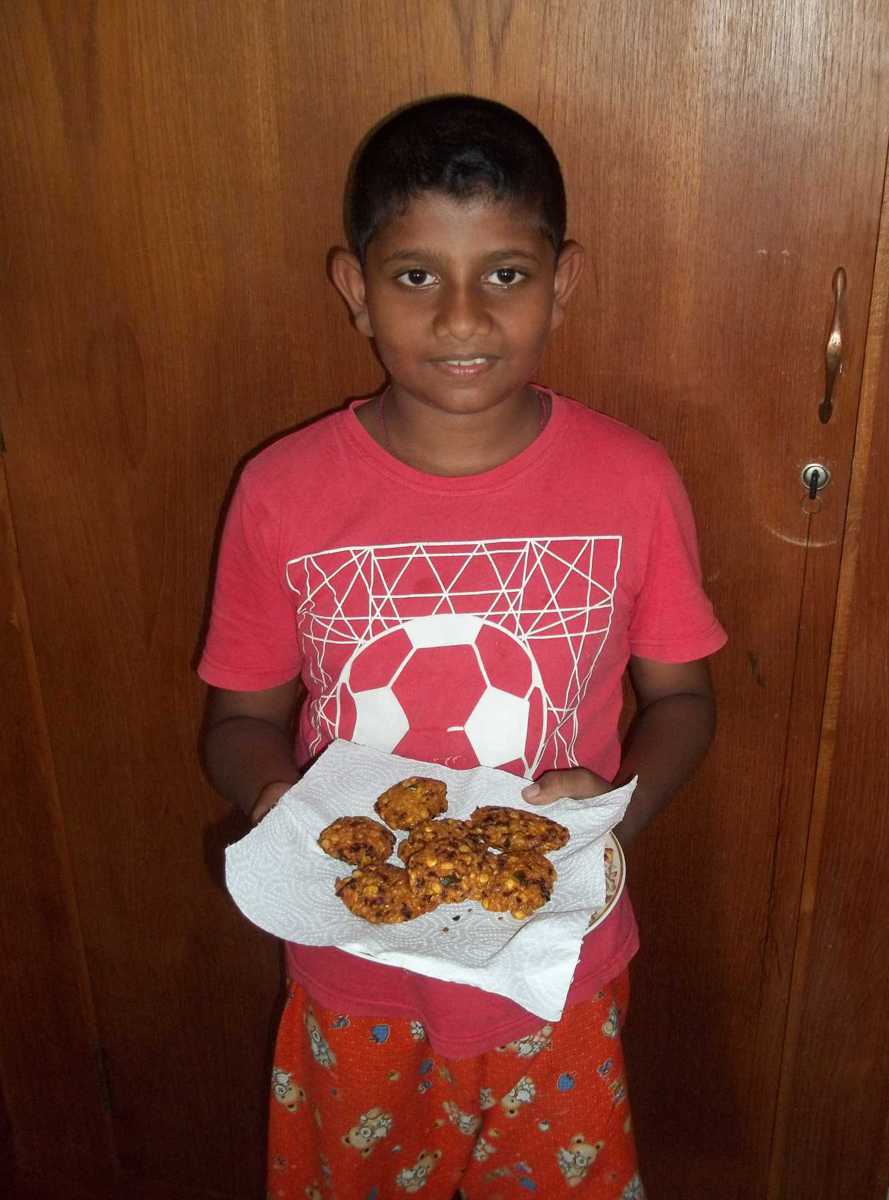 |
 |
 |
 |
||||||||||
| Shehan with vadai he cooked for a school project | Lily in a hand-painted Bengali sari | A painting An did for us thirty years ago now hangs in our guest room. | A new wall hanging in our courtyard | ||||||||||
For the first few days after we arrived in Bangkok, the only news we heard was of Daw Aung San Suu Kyi's landslide victory in the Burmese election. It is certainly thrilling, but we cannot help but feel a little removed from it because we're not actively involved with Burma anymore. Without close Burmese activist friends nearby, we've had noone to celebrate Daw Suu's massive victory with and noone to talk with about the perils of taking power, the military's latest offensives in Kachin and Shan States, the dreadful loss of forests and resources, the disaster that is education in Burma, the future of the refugees in camps in Thailand, and the protection of vulnerable minorities. Although we have Burmese monks and nuns in our classes, they are all young and have no reason to suppose that we deeply care about their country for our own good reasons.
We first visited Burma in 1979 on a one-week visa (the limit in those days). Before 1988, we made a total of eight trips, twice on three-month meditation visas. In July of '88, we went to the Embassy in Bangkok, which was overflowing with frustrated journalists, trying to get into Burma. We marched up to the counter, submitted our passports, and immediately received the three-month visas we'd applied for two years before. At the Strand Hotel, we saw Gen. Ne Win resign. Meditating at Mahasi Yeiktha, we could hear turmoil in streets. After we were informed of the accidental death of a friend, a poet, we asked U Pandita Sayadaw for permission to go to Mandalay, and he agreed. What we learned that summer in Rangoon, Mandalay, Sagaing, and Mingun committed us to involvement. We left the country just before Daw Aung San Suu Kyi spoke to a million people at Shewdagon. We carried out news of the massacre at Sagaing which we shared with Bertil Lintner, met Daw Aye Aye Thant in Bangkok (She was raising funds to send in plasma and emergency medical supplies.), and resolved to support the students and monks on the border until their revolution succeeded.
For the next 17 years, much of our life in Japan revolved around Burma--raising money and increasing awareness of human rights, refugee needs, and the plight of political prisoners. We spent every summer in Thailand, visiting Mae Tao Clinic, refugee and ABSDF camps, ABYMU monasteries, and the Immigration Detention Center at Suan Plu; attending CCSDPT meetings; discussing projects; and collecting crafts for our refugee bazaars. Many friends from Japan (and later from the US) joined our "tours" to learn about the Burmese crisis and to become involved.
Remembering the short-lived optimism of the 1990 election and the euphoria when Daw ASSK won the Nobel Peace Prize in '91, we can only hope that the amazing energy and enthusiasm of this election will last and will be strong enough to sweep the NLD into the place from which they can govern effectively. It will surely take a miracle, but nothing is certain, except change, and there has been little of that since 1962.
Recently, from an article by Chris Hedges, posted on Truthdig.com, we gained a new perspective on the mess the world is in. It is rather long, but we feel that it is well worth reading. It is a concise explanation of the late Professor Sheldon Wolin's concept of "inverted totalitarianism."
We were shocked along with the rest of the world to hear about the horrific attacks in Paris. We joined in mourning the deaths of so many innocent victims. As we watched the incessant coverage on all of the satellite channels, we could not help but recall the vengeful rhetoric of 9-11. At that time, also, no one was allowed to ask, "Why?" The anti-Muslim commentary on some broadcasts was ignorant, inflammatory, and vile. Only the rare journalist dared to point out the obvious: the origin of ISIL is clear; the responsibility falls almost entirely on George W. Bush and the invasion of Iraq, which, let us not forget, had absolutely nothing to do with the attack on the WTC or mythical WMD, but has certainly served to enrich arms manufacturers.
Shortly before the Paris attacks, bombs went off in Beirut, killing 43 people, but hardly anyone paid attention or mourned for them. Thousands upon thousands have been killed by western bombs in Afghanistan, Syria, Libya, and Yemen. Since March 2003, more than one million Iraqi civilians have been killed in the "attack on terror." This, too, should be news, but the mainstream media too often dehumanize Arabs, Muslims, and all people of color. We recalled the candle light vigil we held in Flint, years back, reading alternately the names of Iraqis and US soldiers killed in the war. Those were early days – we finished after a few hours.
Even more distressing was the news that in retaliation, France and the US launched new bombing raids, to be carried out without mercy, on ISIL in Syria.
Maybe we all need to listen again to Buffy Sainte-Marie singing her "Universal Soldier."
|
His orders come from far away no more,
They come from here and there and you and me, And brothers can't you see, This is not the way we put the end to war. |
|
|
Hatred is never appeased by hatred in this world.
By non-hatred alone is hatred appeased. This is a law eternal. –--Dhammapada 5 |
|
The latest attacks seem to have hardened the hearts around the world even more against refugees as strident voices call for vengeance. Most of the asylum seekers, euphemistically called "migrants" (more than 600,000 so far this year), escape through Turkey and risk their lives in a dinghy to Greece. Many, especially children, drown in the Aegean Sea. Our friend, Carol, has introduced us to Sea of Solidarity, an NGO which is trying to help. One of her do-workers is currently in Lesbos with SoS, rescuing refugees and providing them with food, hot tea, thermal blankets, dry clothes, and basic medical services--a worthy and noble cause.
P.S. Ken's shingles have disappeared!